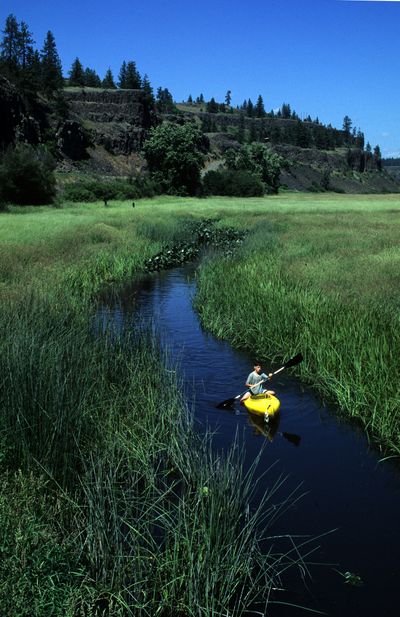A tough sell
State wildlife agency raises resentment with habitat plan

Several families with farms south of Turnbull National Wildlife Refuge are upset with a long-term state plan to preserve a corridor of wildlife habitat stretching from Chapman Lake south around Bonnie Lake to Rock Lake.
The discontent was active recently, prompting the Washington Department of Fish and Wildlife to announce Wednesday the withdrawal of an application for a $1.2 million grant that might have been used to kick start the plan.
The agency had made a preliminary application to the Washington Wildlife and Recreation Program for funding to explore the potential for land purchases, conservation easements or estate planning options to help protect key wildlife areas from development.
“We’re talking about a project that’s looking out 20 or 30 years,” said Brian Trickel, the agency’s East Side lands supervisor based in Spokane. “It might take many phases. All we want to do at this point is see if anybody is interested and explain what we can offer.
“If they’re not interested, we leave a card and ask them to give us a call if they change their minds.”
Wildlife biologists have identified a corridor of Rock Creek-area riparian zones key to production, shelter and movements for wildlife ranging from songbirds to elk in this scablands region.
Steve Pozzanghera, WDFW regional director, emphasized the program could proceed only with landowners willing to sell property or negotiate easements.
But several area landowners have said they’re not only opposed to the proposal, they also resent the state probing the area for interest.
“This creates a stress we don’t really need,” said Julie Pittmann, whose family owns land around Bonnie Lake. The lake straddles the Spokane-Whitman county line.
Because of the discontent, including calls to county commissioners and state legislators, the department has decided to withdraw its application for 2010, Pozzanghera said. However, the state remains interested in the project and working with landowners to protect the habitat, he said.
Most of the waters and wetlands in this area are surrounded by private land. However, Bonnie Lake is accessible to the public via a serpentine outlet stream that can be negotiated in a small boat from an undeveloped access. The lake attracts paddlers and anglers, but farmers and ranchers were way ahead of them.
Pittman said her family settled in the area in 1882, before Washington was a state.
“We’re five generations,” she said. “The idea of selling is not something we’re interested in.”
“Our biggest gripe is that they want to give all the public access to this area,” said Barbara Curtis of the Chapman Lake area in Spokane County. “This area has dangers: cliffs that people would be climbing around on, rattlesnakes, and the potential for fire in areas where there are no roads.”
These landowners, and at least several others, said they became concerned when they read a notice about the proposals in a Colfax newspaper and then sought maps from the state that showed all of their property in the WDFW’s area of interest.
“The critical habitat is a relatively thin corridor,” Trickel said. “But in making the proposal we have to show who owns the rest of the land associated with it.”
Curtis said she’s also angry that the agency announced a public meeting Tuesday evening to answer questions about the habitat plan.
The meeting was supposed to be for the landowners, she said, noting that she’d made the arrangements.
Trickel said agency staff would be at the meeting to “present the facts and respond to the misinformation and rumors about taking over people’s land.”
Competition is fierce for the state Wildlife and Recreation funding.
“There’s no guarantee we can get it,” Trickel said.
“But if any landowners have any interest, we’d need to start with planning and appraisals. We’d need money in the pot to make initial agreements.”
“We also work with conservation easements, where land remains in private ownership and owners are paid to leave land unchanged,” said Kevin Robinette, WDFW regional wildlife manager
“If there’s no interest in the options,” Trickel explained, “any grant money we might receive would simply turn back to the (state) Recreation and Conservation Office to be given to the next ranking applicant on the grant list.”
Public land acquisitions or easements often require years to complete, he said.
“I worked 12 years on the Schlee property in the Blue Mountains,” Trickel said, referring to a $3.5 million deal in 2003 for 8,500 acres that have been added to the Asotin Creek Wildlife Area.
“You never know when a piece of land will become available,” said Darrel Olson, who worked for 20 years as a private real estate broker to facilitate land deals with willing sellers for the U.S. Bureau of Land management in Eastern Washington.
“Circumstances change,” he said, noting that sickness, death, retirement, markets and other situations can influence a landowner’s decision overnight.
WDFW officials said about 30 landowners are associated with the area of interest for the habitat corridor proposal and some of them have shown interest in at least talking about the plan.
But Pittman said her family’s position was firm.
“We’re taking care of the habitat the best we can,” she said. “We don’t feel we need Fish and Wildlife to come in and take care of it.
“Who’s going to take care of my security if part of this land is opened to the public?
“Who’s going to handle the fencing and the weeds?
“And I doubt that we’re interested in conservation easements. We’ve already dealt with Avista. … In the 1920s, the state wanted to buy our land and my grandfather wrote back and said he wasn’t interested. It came up again in the ’50s, the ’70s and the ’90s, and here we are now, still not interested.”